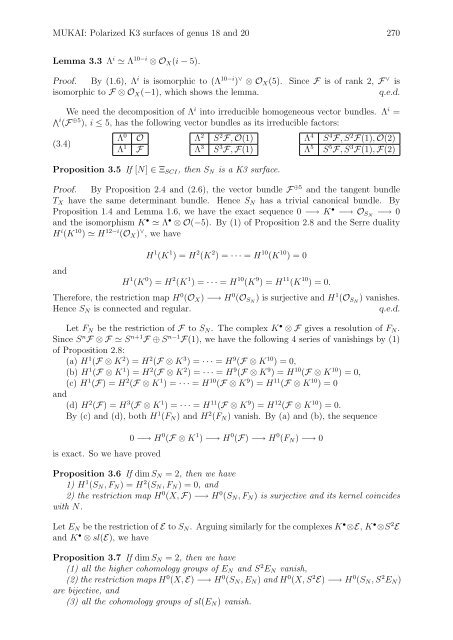Polarized K3 surfaces of genus 18 and 20 - Research Institute for ...
Polarized K3 surfaces of genus 18 and 20 - Research Institute for ...
Polarized K3 surfaces of genus 18 and 20 - Research Institute for ...
Create successful ePaper yourself
Turn your PDF publications into a flip-book with our unique Google optimized e-Paper software.
MUKAI: <strong>Polarized</strong> <strong>K3</strong> <strong>surfaces</strong> <strong>of</strong> <strong>genus</strong> <strong>18</strong> <strong>and</strong> <strong>20</strong> 270<br />
Lemma 3.3 Λ i ≃ Λ 10−i ⊗ O X (i − 5).<br />
Pro<strong>of</strong>. By (1.6), Λ i is isomorphic to (Λ 10−i ) ∨ ⊗ O X (5). Since F is <strong>of</strong> rank 2, F ∨ is<br />
isomorphic to F ⊗ O X (−1), which shows the lemma.<br />
q.e.d.<br />
We need the decomposition <strong>of</strong> Λ i into irreducible homogeneous vector bundles. Λ i =<br />
∧ i<br />
(F ⊕5 ), i ≤ 5, has the following vector bundles as its irreducible factors:<br />
(3.4)<br />
Λ 0<br />
Λ 1<br />
O<br />
F<br />
Λ 2<br />
Λ 3<br />
S 2 F, O(1)<br />
S 3 F, F(1)<br />
Λ 4<br />
Λ 5<br />
S 4 F, S 2 F(1), O(2)<br />
S 5 F, S 3 F(1), F(2)<br />
Proposition 3.5 If [N] ∈ Ξ SCI , then S N is a <strong>K3</strong> surface.<br />
Pro<strong>of</strong>. By Proposition 2.4 <strong>and</strong> (2.6), the vector bundle F ⊕5 <strong>and</strong> the tangent bundle<br />
T X have the same determinant bundle. Hence S N has a trivial canonical bundle. By<br />
Proposition 1.4 <strong>and</strong> Lemma 1.6, we have the exact sequence 0 −→ K • −→ O SN −→ 0<br />
<strong>and</strong> the isomorphism K • ≃ Λ • ⊗ O(−5). By (1) <strong>of</strong> Proposition 2.8 <strong>and</strong> the Serre duality<br />
H i (K 10 ) ≃ H 12−i (O X ) ∨ , we have<br />
<strong>and</strong><br />
H 1 (K 1 ) = H 2 (K 2 ) = · · · = H 10 (K 10 ) = 0<br />
H 1 (K 0 ) = H 2 (K 1 ) = · · · = H 10 (K 9 ) = H 11 (K 10 ) = 0.<br />
There<strong>for</strong>e, the restriction map H 0 (O X ) −→ H 0 (O SN ) is surjective <strong>and</strong> H 1 (O SN ) vanishes.<br />
Hence S N is connected <strong>and</strong> regular.<br />
q.e.d.<br />
Let F N be the restriction <strong>of</strong> F to S N . The complex K • ⊗ F gives a resolution <strong>of</strong> F N .<br />
Since S n F ⊗ F ≃ S n+1 F ⊕ S n−1 F(1), we have the following 4 series <strong>of</strong> vanishings by (1)<br />
<strong>of</strong> Proposition 2.8:<br />
(a) H 1 (F ⊗ K 2 ) = H 2 (F ⊗ K 3 ) = · · · = H 9 (F ⊗ K 10 ) = 0,<br />
(b) H 1 (F ⊗ K 1 ) = H 2 (F ⊗ K 2 ) = · · · = H 9 (F ⊗ K 9 ) = H 10 (F ⊗ K 10 ) = 0,<br />
(c) H 1 (F) = H 2 (F ⊗ K 1 ) = · · · = H 10 (F ⊗ K 9 ) = H 11 (F ⊗ K 10 ) = 0<br />
<strong>and</strong><br />
(d) H 2 (F) = H 3 (F ⊗ K 1 ) = · · · = H 11 (F ⊗ K 9 ) = H 12 (F ⊗ K 10 ) = 0.<br />
By (c) <strong>and</strong> (d), both H 1 (F N ) <strong>and</strong> H 2 (F N ) vanish. By (a) <strong>and</strong> (b), the sequence<br />
is exact. So we have proved<br />
0 −→ H 0 (F ⊗ K 1 ) −→ H 0 (F) −→ H 0 (F N ) −→ 0<br />
Proposition 3.6 If dim S N = 2, then we have<br />
1) H 1 (S N , F N ) = H 2 (S N , F N ) = 0, <strong>and</strong><br />
2) the restriction map H 0 (X, F) −→ H 0 (S N , F N ) is surjective <strong>and</strong> its kernel coincides<br />
with N.<br />
Let E N be the restriction <strong>of</strong> E to S N . Arguing similarly <strong>for</strong> the complexes K • ⊗E, K • ⊗S 2 E<br />
<strong>and</strong> K • ⊗ sl(E), we have<br />
Proposition 3.7 If dim S N = 2, then we have<br />
(1) all the higher cohomology groups <strong>of</strong> E N <strong>and</strong> S 2 E N vanish,<br />
(2) the restriction maps H 0 (X, E) −→ H 0 (S N , E N ) <strong>and</strong> H 0 (X, S 2 E) −→ H 0 (S N , S 2 E N )<br />
are bijective, <strong>and</strong><br />
(3) all the cohomology groups <strong>of</strong> sl(E N ) vanish.
















